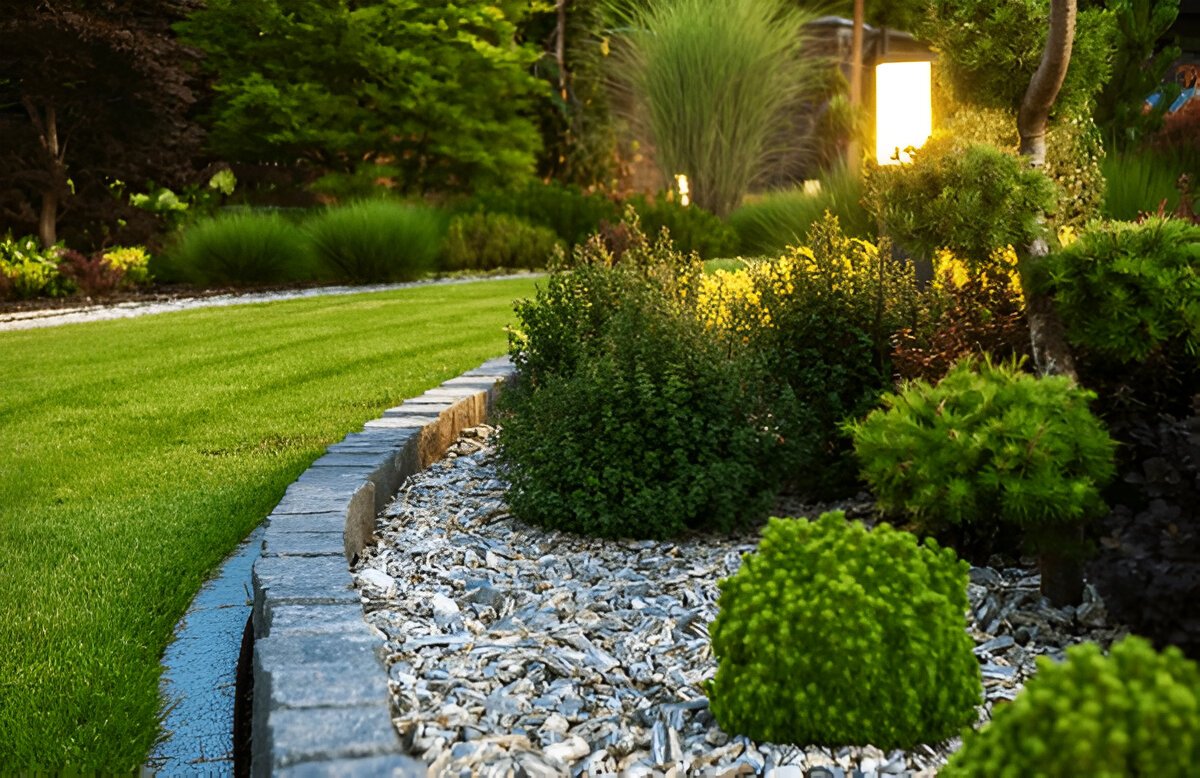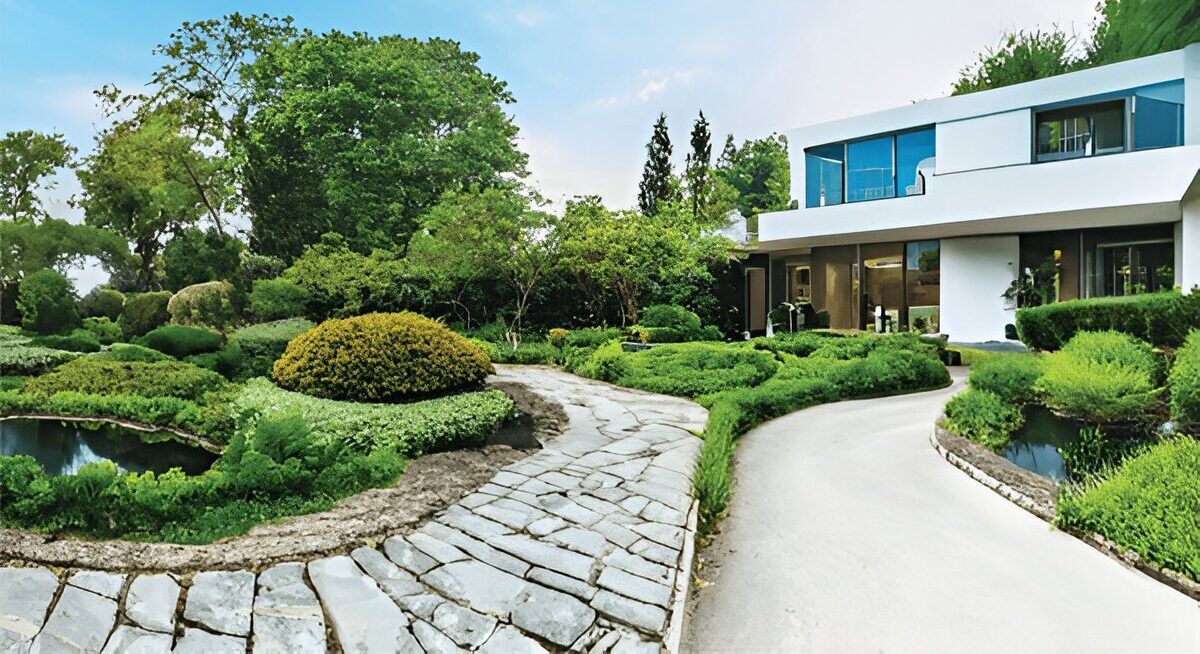Landscape Architecture Design Explained: Modern Outdoor Lifestyle Solutions
Picture yourself unwinding in a lush courtyard in bustling Delhi, where the air carries hints of jasmine and the gentle trickle of a fountain eases the day’s tensions. This scene embodies outdoor lifestyle solutions, seamlessly merging innovative landscape architecture with daily rejuvenation. In India, such designs tackle rapid urbanization while nurturing personal harmony and environmental balance.
Homeowners and designers alike pursue these enhancements with growing enthusiasm. As cities expand, intentional green areas emerge as sanctuaries for rest and connection. A thoughtfully planned terrace, for example, transforms overlooked rooftops into inviting havens that encourage family gatherings.
Experts advocate for designs attuned to regional ecosystems. Drought-tolerant species flourish in arid zones like Jaipur, demanding less upkeep while delivering vibrant colors year-round. These strategies not only sustain beauty but also adapt to India’s diverse climates effectively.
Professionals at an outdoor lifestyle solutions company in India begin projects with thorough site evaluations. They analyze terrain, light exposure, and lifestyle preferences to develop customized blueprints. This foundational step ensures creations that resonate deeply with users over time.
Local craftsmanship further enriches these efforts. Artisans from Gujarat craft intricate lattice screens that filter sunlight softly, blending tradition with modern utility. Heritage elements like these infuse spaces with cultural resonance, creating timeless appeal.
Vertical greenery innovations also gain traction in space-constrained metros like Kolkata. Pocket gardens on walls purify air and cool surroundings naturally. Forward-thinking approaches like these propel outdoor lifestyle solutions into the future, making them accessible and impactful.
Why Outdoor Lifestyle Solutions Matter in Modern Indian Homes
India’s urban fabric evolves swiftly, with more than half the population expected to reside in cities by 2030, as outlined in UN-Habitat projections. Amid this shift, outdoor lifestyle solutions provide essential counterbalances. They weave natural retreats into dense surroundings, promoting vitality and community ties.
The Rise of Biophilic Design
Biophilic principles draw from nature to uplift spirits and productivity. Elements like flowing water features and leafy canopies mimic wilderness indoors and out. Tailored to India, this involves native frangipani groves or reflective koi pools that evoke serene backwaters.
Studies from the World Green Building Council highlight how such integrations significantly lower stress levels and enhance cognitive function. Designers incorporate winding stone trails that invite contemplative strolls, fostering mindfulness in hectic routines. These touches turn ordinary yards into therapeutic escapes.
Furthermore, biophilic elements boost real estate allure. Reports from Knight Frank indicate green-certified properties command premiums of up to 15% in resale value, reflecting buyer demand for wellness-oriented homes. Savvy investors recognize the long-term advantages here. In tier-II cities like Indore, developers now prioritize these features to attract eco-aware millennials.
Health Benefits Backed by Research
Access to verdant outdoors counters desk-bound habits prevalent in urban India. Insights from the Indian Journal of Community Medicine reveal that regular nature exposure correlates with improved physical activity and reduced chronic health risks. Playful meadows in family compounds spark movement, benefiting all ages.
Mental resilience strengthens too. A 2024 NielsenIQ survey underscores how urban dwellers increasingly favor homes with integrated green zones for emotional well-being. Post-pandemic priorities linger, with many viewing personal gardens as vital stress buffers.
Shifting focus to environmental perks, indigenous flora like vetiver acts as natural air cleansers in smog-heavy Ahmedabad. Roots stabilize soil, while leaves trap particulates, yielding cleaner breaths and healthier habitats. Community gardens in such areas also build social networks, reducing isolation.
Regional Adaptations for Wellness
India’s varied terrains demand localized tweaks. Coastal Goa homes feature salt-tolerant mangroves that shield against tides, while Himalayan retreats in Shimla use conifer borders for windbreaks. These adaptations ensure solutions thrive contextually.
Consultants emphasize user-centric zoning. Quiet reading nooks shielded by bamboo screens suit introverted lifestyles, whereas open patios with built-in grills cater to social hosts. Personalization elevates everyday experiences profoundly.
In the Deccan Plateau, terraced herb spirals conserve water while providing fresh ingredients. Architects layer drought-resistant succulents with flowering climbers, creating layered visuals that evolve seasonally. Such details make wellness intuitive and enduring.
Essential Elements of Landscape Architecture for Outdoor Living

Fundamental features anchor resilient designs. Serene water installations soothe senses, complemented by ergonomic lounging areas that host conversations. Harmonize robust pavements with lush turf for textural depth and ease of movement.
Incorporating Water Elements
Cascading rills and serene basins generate calming acoustics that mask city din. In water-scarce Gujarat, greywater systems feed these sustainably, minimizing waste. Such inclusions attract birds, boosting on-site ecology subtly.
Specialists endorse efficient circulation pumps that align with conservation goals. Grand View Research forecasts steady expansion in India’s landscaping sector through 2030, propelled by eco-conscious amenities like these. They enhance livability without excess. Submerged LED accents amplify evenings, turning pools into glowing focal points.
Seating and Social Spaces
Versatile loungers scale with household dynamics. Weathered acacia from Madhya Pradesh endures rains gracefully. Cluster them near herb borders for al fresco dining under starlit skies.
Planners recommend layered privacy through climbers on trellises. In vibrant Lucknow alleys, vine-draped arches buffer sounds, blending seclusion with neighborhood charm. These configurations nurture bonds effortlessly. Built-in storage under benches keeps cushions dry during monsoons.
Lighting and Pathways
Soft-glow fixtures illuminate nocturnal explorations securely. Renewable solar lanterns sync with national green initiatives. Projections suggest widespread integration by 2030, illuminating paths to sustainability.
Meandering mulch trails spark curiosity, diverging from rigid grids. Embed them with glow-in-dark aggregates for whimsical night rambles. Flow emerges naturally, guiding feet with intention. Motion-sensor uplights highlight sculptural trees, adding drama.
For quick reference, consider this table of core elements:
| Element | India-Sourced Materials | Key Benefit |
|---|---|---|
| Water Features | Terracotta Pipes, Laterite Stone | Ambient Cooling & Serenity |
| Seating Areas | Acacia Wood, Coir Cushions | Weather Resistance & Comfort |
| Lighting | Bamboo Lamps, Solar Panels | Eco-Friendly Illumination |
| Pathways | Laterite Gravel, Brick Chips | Erosion Control & Aesthetics |
Sensory Integration
Engage all senses for immersive retreats. Aromatic basil hedges release scents on breezes, while textured pebble mosaics invite barefoot wanders. Soundscapes from wind chimes harmonize with rustling palms.
Incorporate edible accents like dwarf guava trees for tactile harvests. These multisensory layers deepen emotional connections, making spaces feel alive and responsive. Tactile play areas with smooth river stones engage children, promoting sensory development.
Sustainable Practices in Indian Landscape Design
Eco-principles guide progressive visions. Indigenous species slash hydration demands by up to half, according to the Indian Green Building Council. Prioritizing them fortifies against climate shifts.
Native Flora Integration
Vibrant lantana and resilient karonda root deeply in local soils. They sustain bees essential for crop pollination nationwide. Townships in Coimbatore report marked drops in watering needs through such selections.
Professionals stress pre-plant soil audits. Enriched substrates promote vigorous growth, cultivating enduring biomes. This groundwork yields flourishing, self-regulating gardens. Companion planting with marigolds deters pests naturally, reducing chemical use.
Water Management Techniques
Capture monsoon flows via sloped channels to irrigate beds. Mumbai’s bylaws now require such setups in developments. Swales with gravel beds cleanse runoff organically.
CBRE’s 2024 analysis points to initial upticks in eco-build outlays, offset by swift returns through reduced bills. Forward planning unlocks these efficiencies. Drip emitters buried in mulch deliver precise moisture, mimicking natural rainfall.
Eco-Friendly Materials
Rapidly renewing bamboo frames provide dappled shade sans habitat loss. Harvested from Assam groves, it cycles quickly. Ground covers from coconut husks retain moisture, curbing evaporation.
These choices trim emissions notably. The landscaping market in India aims for USD 8.9 billion by 2030, spurred by green innovations. Lasting impacts blend with visual splendor. Recycled plastic composites form durable edging, preventing soil erosion stylishly.
An outdoor lifestyle solutions company in India masters these integrations for unique visions. Clients witness tangible eco-advances paired with aesthetic delight. Bespoke strategies amplify both.
Soil and Biodiversity Enhancement
Compost from kitchen scraps nourishes earthworms, aerating grounds naturally. In Bengaluru estates, mycorrhizal fungi inoculants boost root networks, enhancing drought tolerance. Diversity flourishes as understory ferns shelter insects.
Monitor progress with simple biodiversity audits. Track bird species or butterfly visits to gauge success. These metrics inspire ongoing refinements. Cover crops like clover fix nitrogen, enriching depleted urban soils over time.
Integrating Technology and Innovation in Designs
Digital tools amplify creativity. Sensors gauge humidity, fine-tuning feeds remotely. Interfaces log growth, alerting to interventions. These advancements make maintenance intuitive, even for novices.
Smart Irrigation Systems
Precision drips link to forecasts, curbing overuse by 20-50%. Jaipur estates automate for erratic rains, blending tech with tradition. Simplicity yields profound conservation.
Providers tailor kits for Indian grids. Seamless apps empower owners, demystifying upkeep. Voice-activated controls integrate with home assistants, allowing hands-free adjustments during routines.
Augmented Reality Tools
Overlay simulations let clients roam virtual realms on phones. Envision arbors in real-time, slashing alterations. Chennai firms accelerate sign-offs, streamlining workflows.
This visualization cements confidence, bridging concepts to reality fluidly. Collaborative AR sessions enable real-time tweaks with designers, fostering dynamic partnerships.
Vertical Farming Integrations
Stackable hydro-units cultivate spices on facades. Mumbai innovators harvest steadily, cutting market trips. Paired with panels, they foster independence.
Aligning with nutrition drives, these enrich diets sustainably. Urban yields support self-reliance goals. Nutrient sensors optimize feeds, ensuring bountiful, chemical-free crops year-round.
Planning Your Outdoor Space: Step-by-Step Guide
Embark confidently with this blueprint. Thoughtful preparation turns ambitions into achievements, step by step.
- Site Evaluation: Chart contours and observe seasonal light. Probe earth composition for drainage insights. Document microclimates to inform choices.
- Vision Alignment: Weigh serenity against sociability; doodle functional clusters. Involve family in brainstorming to align on priorities.
- Element Selection: Favor locals like plumeria for flair; spotlight a birdbath centerpiece. Balance aesthetics with functionality for cohesive flow.
- Phased Rollout: Segment tasks—plants first, structures later—for manageable momentum. Set milestones to celebrate progress.
- Expert Engagement: Partner with accredited pros; vet portfolios for alignment. Clear contracts outline expectations from the outset.
Prep with this list:
- Local Regulations: Review zoning for water elements
- Seasonal Timing: Plant pre-monsoon for roots
- Monitoring Tools: Apps for moisture alerts
- Community Input: Poll neighbors on shared aesthetics
Regional Plant Palette
Tailor to terroir for optimal results:
| Region | Recommended Natives | Adaptation Edge |
|---|---|---|
| North (Delhi) | Neem, Amaltas, Bougainvillea | Heat Tolerance, Low Water |
| South (Chennai) | Hibiscus, Vetiver, Ixora | Humidity Resistance |
| West (Mumbai) | Karonda, Lantana, Teak Saplings | Saline Soil Suitability |
| East (Kolkata) | Palm, Frangipani, Ginger Lily | Flood-Prone Resilience |
Maintenance Roadmap
Sustain vibrancy with routines:
- Weekly: Prune spent blooms; check mulch levels.
- Monthly: Inspect for pests; replenish compost.
- Seasonally: Aerate lawns; divide perennials.
- Annually: Soil test; redesign underperformers.
These habits preserve investments, adapting to evolving needs.
Conclusion
Outdoor lifestyle solutions reshape Indian abodes into nurturing extensions of self. Biophilic infusions, sustainable tactics, and tech infusions merge allure with acuity. Nationwide insights chart viable routes, blending innovation with tradition.
FAQs
What native plants suit sustainable outdoor lifestyle solutions in Mumbai’s coastal climate?
Choose karonda, lantana, and coastal palms for salt tolerance and minimal care. They attract pollinators while stabilizing sandy soils. Integrate them for resilient, vibrant edges.
How does biophilic design enhance small apartment terraces in urban India?
Incorporate trailing vines, pebble trays, and herb spirals to evoke wilderness compactly. These foster calm amid confines, per World Green Building Council insights. Quick setups yield profound peace.
Which 2025 trends define landscape architecture in India?
Climate-adaptive natives, smart hydration, and wellness pods lead, alongside vertical edibles. Grand View anticipates 6.8% sector growth to 2030. Resilience anchors progress.
How to safeguard designs against monsoons in Kerala?
Opt for elevated beds, permeable drains, and sturdy teak frames. Prune pre-rains; native ferns absorb excess. Durability ensures seasonal grace.
Why partner with an outdoor lifestyle solutions company in India?
They navigate locales expertly, fusing culture with cutting-edge greens. Customized eco-plans deliver enduring joy. Expertise turns dreams into thriving realities.






Comments are closed